Please Take Note: This is a review of the final game, but it might change slightly based on the success of the Kickstarter campaign. The game is being reviewed on the components and the rules provided with the understanding that “what you see is not what you might get” when the game is published. If you like what you read and want to learn more, we encourage you to visit the game publisher’s website or visit the Kickstarter campaign. Now that we have all that disclaimer junk out of the way, on with the review.
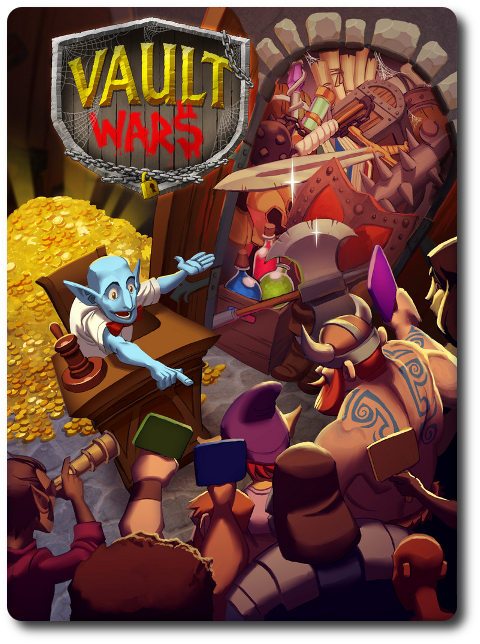
The Basics:
- For ages 10 and up
- For 2 to 5 players
- Approximately 60 minutes to complete
Geek Skills:
- Active Listening & Communication
- Counting & Math
- Logical & Critical Decision Making
- Reading
- Memorization
- Strategy & Tactics
- Risk vs. Reward
- Hand/Resource Management
- Self-confidence
- Imagination
- Bluffing and Misdirection
- Auctioning & Bidding
Learning Curve:
- Child – Easy
- Adult – Easy
Theme & Narrative:
- Profit from a dead hero’s loss!
Endorsements:
- Gamer Geek approved!
- Parent Geek approved!
- Child Geek rejected!
Overview
There are two ways to make your fortune in this world. The first is to go bravely forth into a forsaken dungeon, battle whatever unspeakable evil may live there, and return with a hoard of treasure. The second way is to wait until those foolish enough to venture into the darkness don’t come back and then claim their treasure for your own. You elected for the safer path to earn your fortune, but instead of dragons, you’ll be battling against greedy bidders. In this game, a sword won’t win the day, but a sharp mind most certainly will.
Vault Wars, designed by Jonathan Gilmour and to be published by Floodgate Games, will reportedly be comprised of 73 Item cards, 16 Vault cards, 10 Aspiring Hero cards, 1 Loan Shark card, 60 Coin tokens (in the values of 1, 5, and 10), and 12 Corruption tokens. As this is a review of a prepublished game, I will not comment on the game component quality. The proposed artwork by Jacqui Davis and Kelly McClellan is superb, reinforcing the game’s theme and narrative throughout.
Note: This review contains a mix of finished and work-in-progress artwork.
Game Set Up
To set up the game, first shuffle and then deal Vault cards to each player, face-down. The number of cards dealt is dependent on the number of players in the game. Any unused Vault cards are out for the duration of the game.
Second, shuffle the Aspiring Hero cards and deal 2 to each player, face-down. Any unused Aspiring Hero cards are out for the duration of the game.
Third, give each player 5 “1” value Coin tokens and 3 “5” value Coin tokens. The total starting value in Coins is “2o” for each player. All remaining Coin tokens should be placed in a pile. This is the “Bank” for the duration of the game. It helps if you assign one player who is reasonable and trustworthy to be the “Banker”. Feel free to do a background check before assigning the role.
Fourth, shuffle the item cards and place them face-down to form the Item draw deck.
That’s it for game set up. Time to make some legendary bids.
Auction Etiquette
Vault Wars is an auction game which means players will need to think and speak quickly to get what they need. Knowing how the auction works and what you will be bidding on is the first step to spending your Coins wisely.
The Vaults
Each Vault card represents a location where some daring hero vanquished evil and then got eaten…or worse. Now the location and all of its contents are for sales to the highest bidder.
But there’s a catch.
The location has not been fully explored and not all the items it contains have been identified. If truth be told, the accuracy of inventory collecting leaves much to be desired, but that’s what you get when you hire goblins without references. Each Vault card identifies the Vault Priority Number, the number of Item cards that vault contains, the number of those Item cards that players can look at, the number of Secret Item cards the players can peek at, and any special auction rules that must be obeyed during the game.

The Items
Each vault contains a hoard of items. Not all of them are worth anything and some are worth more than a kingdom. As you can imagine, there is a healthy mix of items to be won and knowing their true value is as much an art form as it is just stupid luck.
Vaults are full of valuable stones and exquisitely cut jewels. They are worth a great deal alone, but the more the player collects, the more they are worth. There are also some rare items, such as the Dragon Egg, that must be collected in abundance or they will cost the player points!
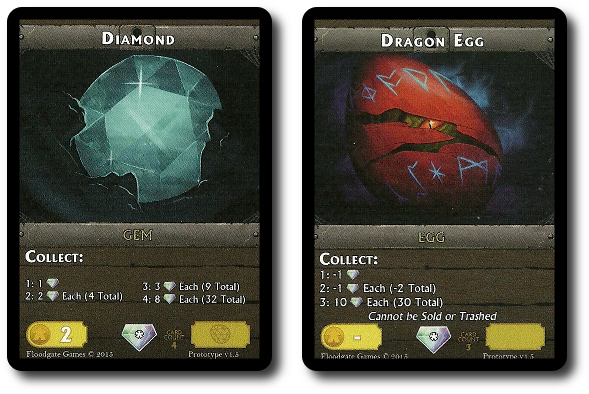
Vaults also contain legendary weapons and armor that are sure to look good displayed on a wall or behind glass. Individually, these items are excellent conversation pieces. If you can collect the entire set, you’ll be the talk of the town.
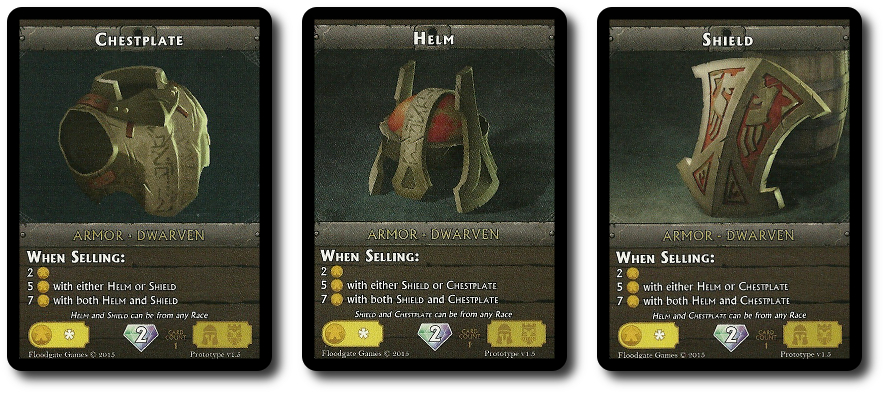
A few of the vaults even contain artifacts. Artifacts give the player who owns them special abilities. For example, some artifacts can be equipped to provide the player a special bonus during certain phases and steps in the game, while others give the player a way to obtain a unique advantage over their opponents.

Finally, vaults also contain junk. Trash, splintered doors that were kicked in, cracked chamber pots, skeletons, mold, cobwebs, and the ugliest drapes you have ever seen. Of course, these items are not listed on the auction flier, as that document focuses on over emphasizing the vault’s worth versus listing rubbish. Still, even junk can be worth something if enough of it is collected.
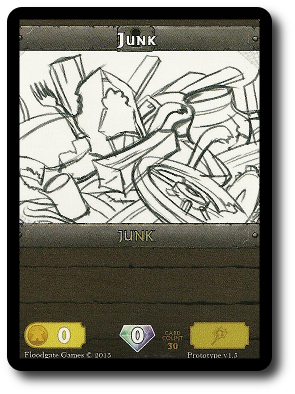
Aspiring Idiots Heroes
It takes a lot of guts to be a hero. You have to fight nasty things, visit dark and dirty places, and your odds of survival are not that great. Of course, the perks are pretty awesome. Free ale at the local tavern, songs written about your exploits, and a chance to make a lot of Coin. Emphasis on “chance”. The statics clearly show that the life expectancy of a newbie hero is slightly longer than the lifespan of a fruit fly (roughly 40 – 50 days, give or take a week). Further more, the amount of effort it takes to pack all that gear, venture forth into a dark cavern, and then get eaten is much more work than the entire experience is worth.
But try telling all this to the would-be adventurers that flock to your door asking for a chance to accompany you to the different vault locations. You can’t help but admire their eagerness to learn and it would be foolish of you to turn them away, especially when they could be so very useful. Each Aspiring Hero card depicts a young and dumb hero who has listened to too many stories in the inn and now thinks they have what it takes to be a legend. Whatever. Until they go off and do something stupid, you plan on utilizing their special talents to further your own goals.
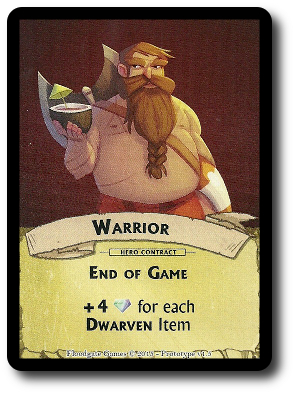
Idiots…
Welcome to the Vault
Vault Wars is played in rounds with no set number of rounds per game. Each round is organized into sequential phases where all players will be given an opportunity to bid on vaults, sell acquired items, and store other items for later use. A round of game play is summarized here.
Phase 1: Preparing the Vaults for Auction
During this phase, each player secretly selects 1 of their Vault cards to place on the auction block. After selecting the Vault card of their choice, they place it in front of them, face-down, indicating they are ready for the game to move on. Once every player has selected a Vault card and placed it down, the Vault cards are simultaneous flipped face-up. Usually, at this point in the game, everyone gets out of their seat to see what is up for grabs, asking cards to be rotated, picked up, handled, and so on until everyone feels confident that they know the value of what is being offered.
Phase 2: Auction
Each Vault cards has a Vault Priority Number. This number value is used to determine the order in which each Vault card will be auctioned off. Priority always goes to the lowest Vault Priority Number, followed by the next lowest value and so on until all the Vault cards have been bid on.
The owner of the Vault card that is being bid on receives the coveted title of “Auction Master”, which is not nearly as cool as being a Dungeon, Dragon, or Kung Fu Master. But it’s a good deal more lucrative. When the Auction Master is ready, the auction and bidding can begin. All auctions follow a simple formula that always results in someone losing coins and claiming items. It’s easiest to describe if I break into steps. Any auction rules defined by the Vault cards always trump the basic rules of the game.
Step 1: Draw and Reveal (Some) Items
Each Vault card lists the total number of Item cards that are up for grabs. The Auction Master now draws that many Items cards from the Item draw deck but DOES NOT LOOK AT THEM. The Vault cards will also list the total number of Item card that are revealed to all and those that are secretly revealed to some. For every Item card that is revealed, randomly select one Item card and place it face-up in front of the Vault card. The remaining Vault cards are passed to the next player in turn order sequence, making sure to keep the card’s face-down.
The Item cards being passed are referred to as the “Secret Items”. From the Secret Item cards, each player will randomly select a number indicated by the Vault card. Players should keep whatever information they discover to themselves, unless they find some reason to tell the truth about what they revealed or want to lie about it. It’s up to the player and a great way to persuade the competition to think one way or the other. When the player is done looking, they shuffle the Secret Item cards and pass them to the next player in turn order sequence. When the Secret Item cards return to the Auction Master, the game continues.
Step 3: Bidding
Bidding begins with the Auction Master who can set the starting bid at any amount they like as long as they do not exceed the total value of Coins they currently own. The next player in turn order sequence can now pass or bid. If they pass, they can pass or bid again when the bidding comes back to them. If they bid, they must raise the current bid amount by at least +1. They must also be able to pay whatever they bid, so no fair saying something like “GAZILLION!”
This continues, going around and around, until everyone passes. The player who gave the highest bid wins the auction! This includes the Auction Master.
Step 4: Collecting the Items
The winner of the auction takes all the items cards attached to the Vault card and places them face-down in front of them. This is the player’s Item pile. The player also collects the Vault card and places it face-up in front of them. The player does not need to reveal any cards in their Item pile, but they may do so if they want to brag about something they won.
Finally, whatever the bid was that won the player all those tasty spoils is now paid to the Auction Master. If the winner of the bid was the Auction Master, then payment is sent to the “Bank” instead.
Phase 2 now repeats, focusing on the Vault card with the next lowest Vault Priority Number. This continues until all the face-up Vault cards have been placed on the auction block.
Phase 3: Getting Paid
This phase of the game only occurs AFTER all the Vault cards revealed by the players have been auctioned off (not all the Vault cards in play).
Simultaneously or is some semblance of order, players may sell off any Item cards they have in their Item pile for their listed Coin value. This is where it’s handy to have a Banker in the game so they can quickly take Item cards and dispense payment. All Items sold are discarded and any Coins earned are placed in the player’s Coin pile. “Junk” Item cards can be discarded at this time, too, but they aren’t worth any Coins.
Before selling Items, players should take into account what items they want to equip and what items are worth keeping around in hopes of completing a set bonus. Equipped items can never be sold, but are often worth their weight in gold if used properly. Collecting just the right set of cards is a gamble, but players will earn more victory points for Item card sets versus any Coins they might earn by selling them.
Players should also consider what bonuses their Aspiring Hero cards provide, making reasonable decision based on bonuses and boons listed on the card.
Visit the Loan Shark
If players have less than “10” Coins after selling any Item cards (players are never forced to sell Item cards), they are welcome to visit the local Loan Shark who is more than happy to help them with their financial situation. His generous spirit, however, comes at a price.
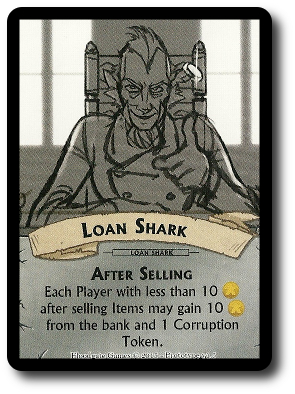
The player will immediately be given “10” Coins to do with as they wish, but they also gain 1 Corruption token. Corruption tokens will reduce victory points at the end of the game. Then the Loan Shark kicks the player out into the street and welcomes them back in during the next round of game play.
Note: The Loan Shark isn’t interested in the player returning his money. Corrupting the player is more than enough “payment” for this twisted creature.
Phase 4: Ending the Round
At the end of the round, players can equip or store the Item cards they still have in their possession.
Equip Items
Item cards that have the keyword “Equip” can be permanently attached to the player for the duration of the game (unless stolen or lost). Equipped Item cards provide abilities that are immediately available to the player, but can only be used during certain phases of the game. For example, if a player were to equip an Item card with an ability that can be used during the “End of Round”, the player can use the ability during this phase of the game right after they equip it.
The only downside to equipping Item card is that they cannot be sold for Coin or used to earn victory points at the end of the game.
Store Items
Any remaining Item cards in the player’s Item pile need to be securely stored. Of course, this will cost the player Coin. For every Item card in the Item pile, the player must pay 1 Coin to the bank. For every Item card the player cannot pay for it is trashed (discarded), but the player receives 1 Coin for their trouble. In this way, players can trash some Item cards in order to save others.
Normally, “Junk” Item cards are worth nothing. During phase 3 of the game, players could not sell their junk for Coin no matter how badly they wanted to. During this phase of the game, the player may trash 3 “Junk” Item cards to earn 1 Coin.
The round is now officially over and the next round begins starting with phase 1 noted above.
Ending the Auction
When the last Vault card has been auctioned off and the round completed, the game is over. It’s time to see who is rolling in riches and who is rolling in regret.
First, let’s focus on the good stuff.
- Add the victory points provided by each Item card in the Item pile
- Add any victory points for any Collection bonuses
- Select 1 Aspiring Hero card, flip it face-up, and add any bonus victory points it provides
- Add +1 victory point for every 10 Coins not spent
And now we need to suffer a few penalties.
- Count the number of Corruption tokens and reduce the total number of victory points as required (1 Corruption token = -2 victory points, 2 Corruption tokens = -3 victory points each, 3 or more Corruption tokens = -4 victory points each)
- Reduce victory points for every “Dragon Egg” Item card not in a set
The end result is the player’s total victory points for the game. It’s possible to have negative points. Remember, players do not score victory points for equipped Item cards.
The player with the most victory points wins the game! Ties are broken first on Corruption tokens and then remaining Coins.
The Workers Game Expansion
The Vault Wars: Workers game expansion includes 12 Worker cards that can be used to inject more cunning, strategy, and tactics into the game. Each Worker card represents 1 hireling that the player can employee for the round in order to make use of their special ability. Only 6 out of the 12 Worker cards are available at first in what is referred to as the “Workers Market”. Once hired, the player can discard their Worker card to activate its ability, but each ability can only be used once and only during certain phases or steps of the game.
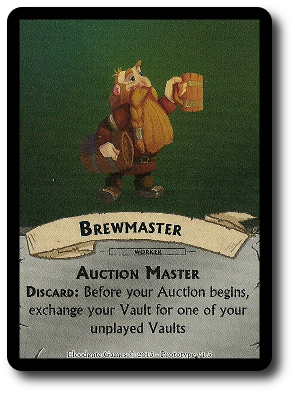
Game Variant
There is a 2-player game variant available, but we didn’t have a chance to play it. Vault Wars plays best with as many players as you can get to the table, but sometimes a party of 2 is all that is available. This game variant makes it possible for 2 players to enjoy the game by introducing a Mysterious Bidder that has endless resources to spend and a taste for specific Items.
To learn more about Vault Wars, visit the game publisher’s website or visit the Kickstarter campaign.
Final Word
The Child Geeks were very eager to learn how to play Vault Wars. They liked the game’s theme and the idea of buying magical weapons, armor, and items. Vault Wars is a surprisingly easy game to teach, but the Child Geeks quickly found out that Vault Wars is not as easy as they assumed. All the Child Geeks understood the bidding, but the lack of funds made each bid a difficult exercise. This was especially true with a large number of players. The Child Geeks also understood how the Item cards worked and should be collected, equipped, or sold. So where did we lose the Child Geeks? One Child Geek summed it up best in a fit of exasperation: “I hate this! I don’t have the money, I can’t tell if you are lying to me, and I can’t bid on what I want!” And there you have it. Vault Wars quickly taught the Child Geeks that the opponents to the left and right of you are only out for themselves, greed rules all, and anything goes when it comes to getting the upper hand. This made each game of Vault Wars, be it with their peers or with their family, a trial of sorts. Another Child Geek said, “I think this game is too adult for me. I understand how to play it, but I can’t get into the game if I never have a chance to win.” In the end, only the oldest of our Child Geeks liked the game, and then only somewhat. All the Child Geeks found Vault Wars easy to learn but a crucible of confusion and frustration to play. One Child Geek even cried. How crappy do I feel? Vault Wars was rejected by our Child Geeks.
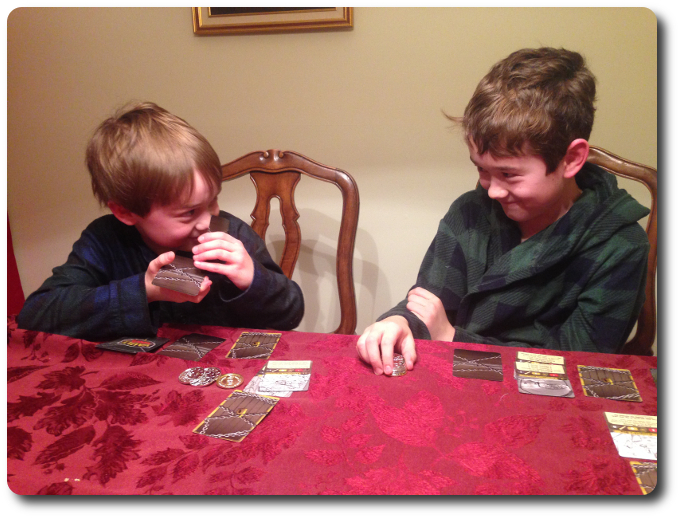
Those smiles are masking simmering rage and growing frustration…
The Parent Geeks learned the same lessons as the Child Geeks, but embraced the game’s cutthroat nature and constant deception with enthusiasm. Well, mostly with enthusiasm. There was also a lot of frustration. According to one Parent Geek, “This game. Let me tell you about this game. It seems so easy, but you spend all your time second guessing yourself, disliking your opponents, and scrambling for money. I’ve gone to the Loan Shark so many times he knows me by first name.” Another Parent Geek said, “This game is brilliant! I haven’t had this much fun losing my money in my entire life! And I’ve been to Vegas!” Each Parent Geek learned that the art of the auction is one part insight and one part mendacity. It was clear to me that some of the Parent Geeks were purposely artificially inflating the importance of some of the Item cards and driving up the bids as a result. Brilliant! In this game, the power to buy is trumped by the power to persuade and the Parent Geeks learned this skill quickly. When all the games were over, the Parent Geeks enthusiastically approved Vault Wars.
The Gamer Geeks found Vault Wars to be a worthy foe that tested their ability to read faces, persuade others, listen for hidden information, and trick the hell out of their opponents. The Gamer Geeks were absolutely ruthless with each other and not a Coin was spent without considering every angle. According to one Gamer Geek, “This is a Gamer Geeks game, without a doubt. It has a lot of depth, takes a lot of skill, and will happily kick you in the crotch if you mess up. I love it.” This coming from a Gamer Geek who HATES fantasy themed games. Another Gamer Geek said, “The levels of depth in this game is a lot of fun. You have to evaluate everything, consider your long-term goals, count the number of Vault cards left, determine if you have enough Coins to make it through a round, and never once stop second guessing everything people say.” The only aspect of the game the Gamer Geeks didn’t like was the lack of funds at times. As one Gamer Geek put it, “It often feels like there isn’t enough cash provided to the players, but I think it’s more likely that the players aren’t being smart with their cash.” Very possible and most likely very true. When all the games were over, the Gamer Geeks applauded Vault Wars and warmly welcomed it back to their gaming table anytime.
This game demands a great deal from its players. This is a game within a game within a game. Players have to keep track of their Coins, their Items in their Item pile, Collection bonuses, abilities from Items if equipped, and the Vault cards they still have. And that’s just what’s in front of the player. Multiply all of that information that needs to be kept track of per player in the game, because players need to have an inkling how much each opponent is possibly worth. Why? Because it all comes down to bluffing. No player really has a strong hand, but it’s very probable that a player has more buying power than another player. Maybe. This is where the bluffing comes in, the table talk is essential, and where we lost the Child Geeks. This game was designed to allow players to trick, lie, and scheme. Victory is awarded to the player with the most victory points, but to earn victory points, you have to grab them from opponents. The best way to do that is to convince opponents that they don’t want Vault cards. And that, my friends, is not easy.
At the core of Vault Wars is a very well designed game, full of depth, tactics, and strategy. Wrapped around it is a game full of deception, self-loathing, and pure rage. You have to cheat others to win and that creates conflict, conflict creates tension, and you MUST use that tension to your advantage! I know! This is not a family game! Unless you live in a really complicated family, in which case, sorry. For everyone else, this is a game that is best played with friends who enjoy a good challenge and are competitive by nature. You have to want to win in order to play this game well, otherwise you will be walked all over and taken advantage of.
Sound like fun? YOU KNOW IT DOES! Do try this game when the opportunity presents itself. You won’t lose your shirt, but you most likely will stress test a few friendships.
This is a paid for review of the game’s final prototype. Although our time and focus was financially compensated, our words are our own. We’d need at least 10 million dollars before we started saying what other people wanted. Such is the statuesque and legendary integrity of Father Geek which cannot be bought except by those who own their own private islands and small countries.



